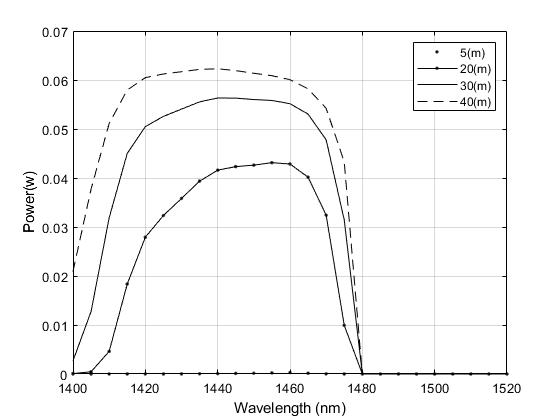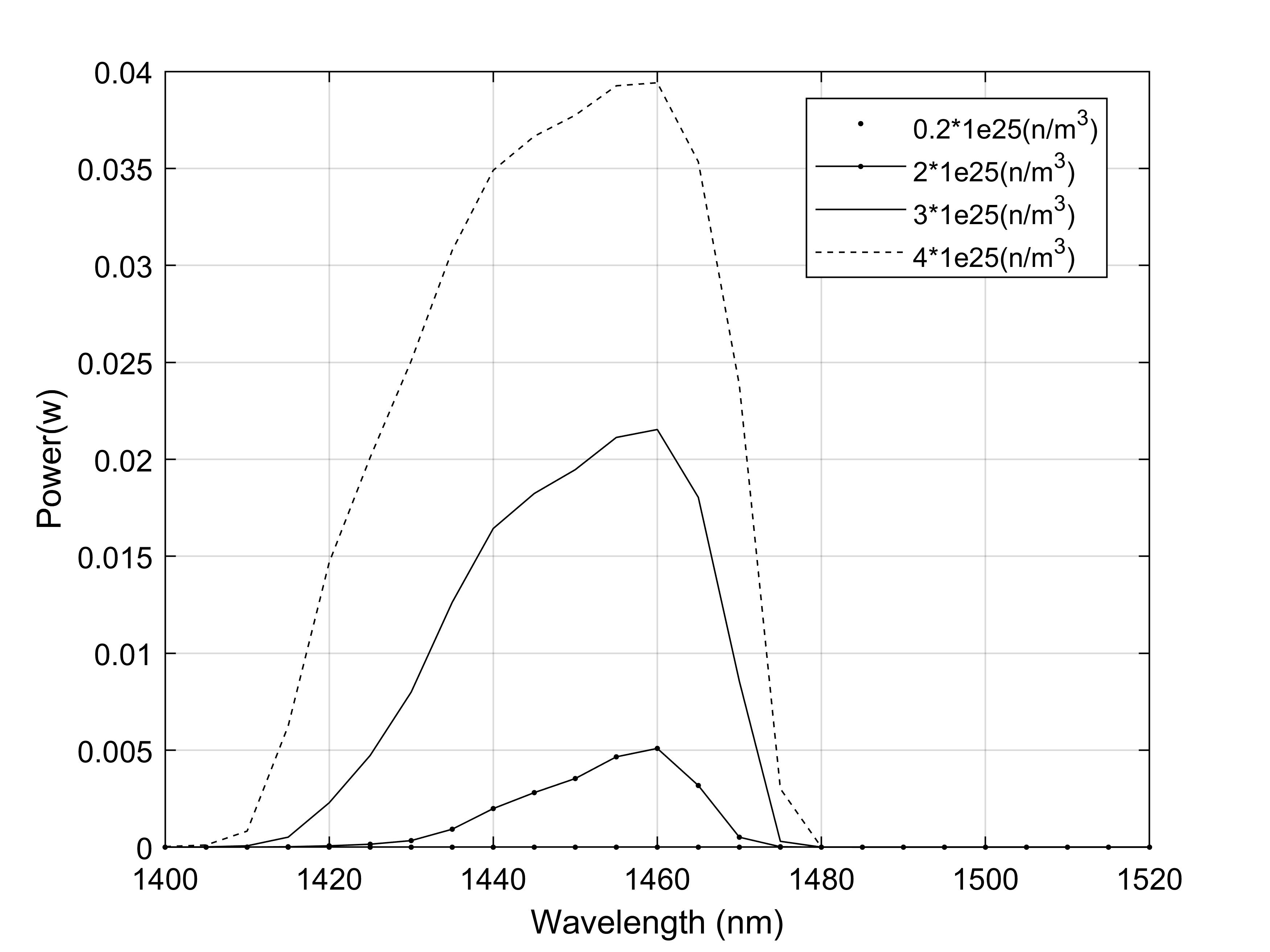1. Introduction
With the continuous development of the global mobile Internet, Internet of Things, cloud computing, and East-West computing, the demand for data communication capacity has exploded. According to the authoritative analyst, global network traffic will reach 4 300 000 petabytes by 2023. Although dense wavelength division multiplexing (DWDM) technology greatly improves the data transmission capacity of existing communication systems. It is far from meeting the growing demand for data transmission. Therefore, the existing optical fiber communication system is facing great pressure to expand. How to fully tap the potential transmission capacity of optical fiber communication systems has become a key problem to be solved. DWDM communication system has become the most mature technology to improve transmission capacity due to its huge bandwidth advantages and spectrum utilization. There are three main ways to improve the transmission capacity of the existing DWDM communication system: (1) increase the transmission rate of the single channel; (2) Reduce the channel spacing and increase the number of channels; (3) Expand the transmission bandwidth and increase the number of channels. However, after more than fifty years of rapid development, the single-channel transmission rate has reached 800 Gb per second, and the channel spacing has reached 50 GHz. Increasing the transmission capacity of the system through the former two ways has approached the Shannon limit, and further improvement will inevitably lead to effects such as dispersion and four-wave mixing, and will also increase crosstalk between channels and reduce system stability. Therefore, compared with increasing the transmission rate of a single channel and reducing channel spacing, expanding the transmission bandwidth and increasing the number of channels has become the preferred expansion scheme because of the advantages of convenient and flexible implementation and high economic benefits. Quartz transmission fiber has a wide (1260~1675nm) and low-loss transmission bandwidth (~415nm). However, the key core device in the current commercial DWDM system, the Er3+ fiber amplifier (EDFA), only uses conventional C-band (1528~1568nm) and L-band (1570~1610nm) with a total bandwidth of about 80 nm, and about 81% of the bandwidth resources have not been fully utilized, which has become an important factor limiting the growth of transmission capacity. Therefore, expanding the gain bandwidth and increasing the number of channels has become the most feasible scheme to improve the transmission capacity of the DWDM communication system, and has been fully valued by academia and industry.
2. Purpose of the study
Fiber-optic communication technology is distinct from optical communication and has become a major pillar of modern communication, playing a central role in today's telecommunications networks. As a rapidly emerging technology, fiber-optic communication has developed quickly and extensively in these days, which is rare in the progress of communication and is also a significant symbol of the world's new technological revolution and the most important tool for transmitting various information into the future information society. The wavelength of optical fiber communication is between 800 and 1600nm, of which the C-band is between 1530 and 1565nm [1]. Erbium-doped fiber amplifier which is called EDFA. As a typical representative of the fiber amplifier, it has the advantages of high gain, low noise, large bandwidth, high pumping efficiency, and stable working performance. However, wavelength between 1400 and 1520nm failed to be put into service. This research is aimed to study thulium-doped fiber amplifiers. The pump wavelength is designed according to the signal wavelength range, energy level structure, and electronic transition process, and the rate equation and power propagation equation are established. Assuming that the pump power is 200mW, programming is used to calculate the change of gain spectrum with fiber length and doping concentration, and optimize the fiber length and doping concentration to maximize the total output power.
3. Numerical model
Thulium ions have a rich energy level structure, which arouses the great attention of scientific research workers recently. Because of the communication band extension, it has been noted that thulium-doped fiber amplifiers are capable of amplifying the S-band [2]. It was found that the absorption cross-section of the 3H4 energy level at its pumping wavelength was much larger than the 3H5 and 3F4 energy levels. The 3F4 to 3H6 pumping scheme belongs to a two-stage system, and it is difficult to achieve particle number inversion. However, there is excited state absorption at the 3H5 energy level, The theory [3] leads to the beneficial conclusion that 3H4 to 3H6 pumping scheme is better. So, This paper uses a three-level structure as a model. When the thulium-doped fiber amplifier is pumped by 790nm optical pumping, the energy level structure can be regarded as a special three-level structure, and the absorption and emission of signal light occur between the second and third energy levels. For fiber lasers, the length of the doped fiber is a very important influencing parameter, which has a straight relationship with the output parameters of the fiber laser.
3.1. Fiber length
For fiber lasers, the length of the doped fiber is a very important influencing parameter, which has a straight relationship with the output parameters of the fiber laser. The output laser wavelength of the thulium-doped fiber laser is located in the 2-micron band, and the 2-micron is located in the water intensity absorption peak, because there is OH in the thulium-doped fiber, and the water molecules have strong absorption of the 2-micron band laser harvest effect. Therefore, if the radium-doped fiber in the thulium-doped fiber laser is longer than certain limits, the laser output power will be reduced because of high absorption. Besides, it will greatly increase the cost of the hole system because of the expensive cost of thulium-doped fiber, which is not conducive to the wide application of thulium-doped fiber laser. If the manganese-doped fiber is shorter than certain limits, then the pump light cannot fully amplify the signal light, wasting the power of the pump light [4].
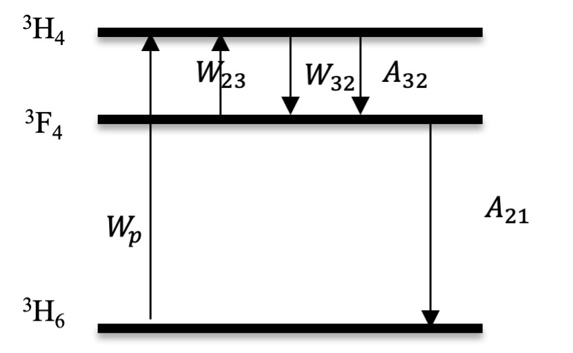
Figure 1. Thulium ions energy level structure.
3.2. Doping concentration
The doping concentration of thulium ions also has an effect on the central wavelength of the output laser of the fiber laser [5][6]. In order to improve the efficiency of thulium-doped fiber lasers, fiber with a high doping concentration of fiber core can be used, which can effectively shorten the length of the doped fiber of the laser, reduce the loss of the laser due to the long fiber matrix, and enhance cross-relaxation process between the thulium ion energy levels, which in turn improves the quantum efficiency of the laser. However, the fiber with high doping concentration is easy to cause thulium ions to form ion clusters, which increases the up-conversion loss and reduces the efficiency. If the doping concentration is too low, in the region where the total effective number of doped particles is lower than the incident photon, the ground state may be exhausted, so the gain effect is terminated [7]. Thulium ion rate equations and thulium ion power propagation equations are shown here.
\( \frac{∂{N_{1}}}{∂t} \) = - \( {W_{p}}×{N_{1}}+{A_{21}}× \) \( {N_{2}} \) (1)
\( \frac{∂{N_{2}}}{∂t} \) = - \( {(W_{23}}+{A_{21}})×{N_{2}}+({A_{32}}+{W_{32}})×{N_{3}} \) (2)
\( \frac{∂{N_{3}}}{∂t} \) = \( {W_{p}}×{N_{1}}+ \) \( {W_{23}}×{N_{2}} \) - ( \( {A_{32}}+{W_{32}})×{N_{3}} \) (3)
\( \frac{d{P_{S}}(z)}{dz} \) = \( {τ_{S}} \) ( \( {σ_{32}}×{N_{3}}-{σ_{23}}×{N_{2}}-{α_{S}} \) ) \( {P_{S}}(z \) ) (4)
\( \frac{d{P_{P}}(z)}{dz} \) = \( {τ_{P}} \) ( \( {σ_{32}}×{N_{3}}-{σ_{13}}×{N_{2}}-{α_{P}} \) ) \( {P_{P}}(z \) ) (5)
\( \frac{d{P_{ASE}}(z)}{dz} \) = \( {τ_{ASE}} \) ( \( {σ_{32}}×{N_{3}}-{σ_{23}}×{N_{2}}- \) \( {α_{s}} \) ) \( {P_{s}}(z \) )+ \( {σ_{32}}{N_{3}}hv∆v \) (6)
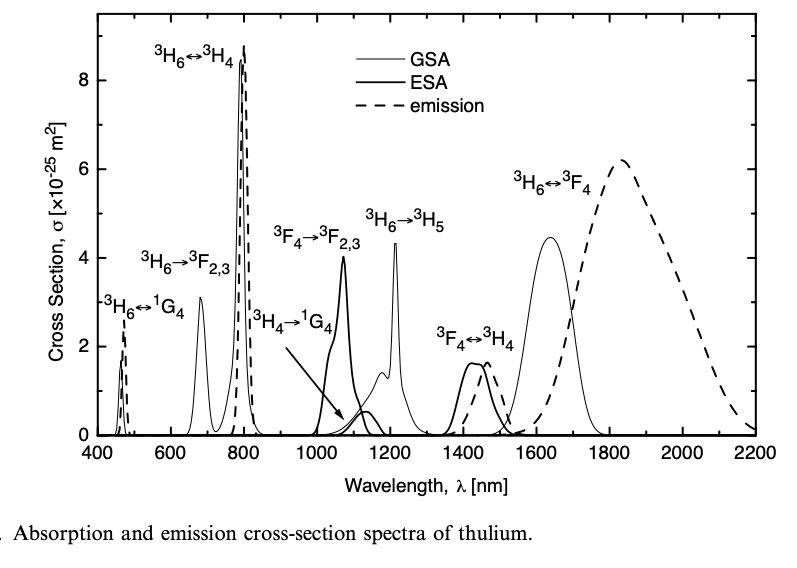
Figure 2. Absorption and emission cross-section spectra of thulium [1].
According to the conclusions of previous studies, the absorption and emission cross-sections of the thulium ion spectrum can be found, extracted from the literature, and fitted using the MATLAB curve fitting tool to get function relationships of emission cross-section, absorption cross-section, and wavelength. And then using the obtained data to further solve the equation system, applying the rate propagation equation and the power propagation equation.
4. Result and discussion
4.1. Output power curves with fiber length and doping concentration
|
| |
Figure 3. Output power curves with fiber length. | Figure 4. Output power curves with doping concentration. |
From Figure 3 it can be seen that within a certain range, the output power gets higher with the increase of the length of the fiber. From Figure 4 it can be seen that in the 1400-1520nm band, the output power increases with the increase of the doping concentration. Since the doping concentration and fiber length affect the amplification effect of the thulium fiber amplifier at the same time, and the effects of the two on the output power cannot be quantified by functional expressions, the optimization algorithm is required to analyze.
4.2. Genetic algorithm
The genetic algorithm came out of the computer simulation research on biological systems, and is a method for optimizing random global search [8], which simulates natural selection and genetic replication, crossover and mutation, and other phenomena. It starts from a random initial population, through random selection, crossover, and mutation operations, to create a group of individuals more suited for the environment, and the population is moving towards the search space for a better place. As generation continues to reproduce and evolve, it finally generates a group of individuals who are most adapted to the environment and this group is a suitable solution to the problem. A genetic algorithm is used to optimize fiber length and doping concentration to find maximum output power. The genetic algorithm is an aggregate optimization probability algorithm, the main features are: First, the genetic algorithm has few mathematical needs for the optimization problem solved, and due to the evolutionary characteristics, the research process does not need the inherent properties of the problem. Whether the equations are linear or nonlinear, discrete or continuous, all of them can be handled. In other words, it can directly operate on structural objects. Secondly, the morphological history of evolutionary operators makes genetic algorithms very efficient in conducting global searches of probabilistic significance. Besides, Genetic algorithms can offer great flexibility for various special issues in order to mix independent heuristics from the construction domain, thus ensuring the efficiency of the algorithm. This gives it a unique advantage in solving such problems. The genetic algorithm flowchart is shown below [9]:
Figure 5. Genetic algorithm flowchart.
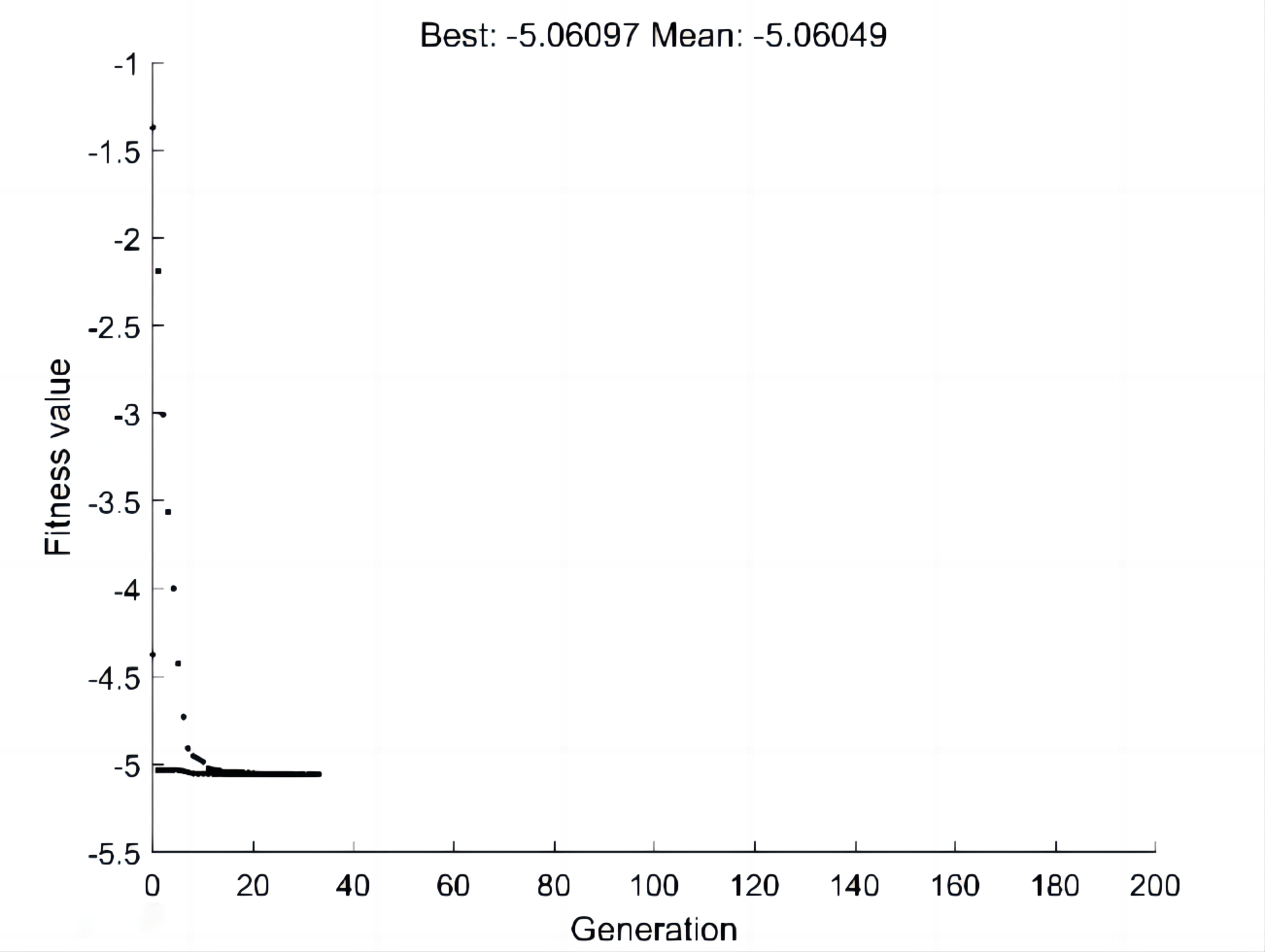
Figure 6. Genetic algorithms used in optimizing parameters.
Because genetic algorithms only require each individual's fitness function score, independent of other aspects of the fitness function, they can be used to solve function problems with complex mathematical representations that are difficult or impossible to derivate [10]. Conclusion: Derived from the genetic algorithm, the maximum total power is 5.06097W.
5. Conclusion
Through this research, it can be seen that thulium-doped fiber amplifiers have good amplification and output power at specific doping concentrations and fiber lengths, which lays the foundation for further development and commercialization. In the 1400-1520nm band, when the doping concentration and fiber length increase, the output power increases with the increase of doping concentration. By optimizing two parameters by genetic optimization algorithm, we can get the optimal output power, which is around 5 watts. This result shows the great potential of thulium-doped fiber amplifiers used in S band. Looking forward to the future, it is still a major challenge to achieve S+C+L ultra-wideband amplification in single-core optical fibers through fiber component optimization and rare earth doping design. A lot of basic research is still needed in terms of fiber matrix composition, spectral regulation and waveguide structure. If ultra-wideband amplification of S+C+L or even wider bands can be realized, it will be an epoch-making technological breakthrough in the field of communications. Air division multiplexing technology based on low-mode multi-core fiber is considered to be the key technology to greatly improve communication capacity in the future. However, there are still some difficulties in the research of air separation multiplexing technology, especially the preparation of low-mode multi-core erbium-doped optical fiber, and the matching and performance optimization with other devices of the air separation multiplexing system, such as couplers, multiplexers, pump methods, etc. As a key material for communication upgrading, low-mode multi-core erbium-doped optical fiber is a problem that must be solved and a key development direction in the future. This research may not give an exact instruction about how to use rare earth-doped fiber amplifier in fiber communication, but it reminds us that there are still some effective methods can be used in optimizing fiber communication.
References
[1]. S Peterka, Faure B, Blanc W, Karasek M and Dussardier B 2004 theoretical modeling of S-band thulium-doped silica fiber amplifiers Opt. Quantum. Electron. 36 pp 201–212
[2]. Du G G 2007 Discussion on the designation of energy levels for Tm3+ ions College Phys. 26(12) pp 1994-2023
[3]. Moulton P F, Rines G A, Slobodtchikov E V, Wall K F, Frith G, Samson B and Carter A L G 2009 Tm-Doped Fiber Lasers: Fundamentals and Power Scaling IEEE 15(1) pp 85-92
[4]. Miniscalco J W 2001 Optical and Electronic Properties of Rare Earth Ions in Glasses GTE Laboratories Incorporated
[5]. Lynch S T M, Donegan J F and Maze G 2005 Optimisation of a two-color pumped Tm31-doped ZBLAN fiber amplifier at 1.49 mm IEE Proceedings 153(1) pp 28-32
[6]. Naftaly M, Shen S X and Jha A 2000 Tm3+-doped tellurite glass for a broadband amplifier at 1.47 mm Phys. Rev. B 62 pp 6215
[7]. Lee Y W, Tseng H W, Cho C H, Chen J Z, Chang J S and Jiang S B 2013 Heavily Tm3+-Doped Silicate Fiber for High-Gain Fiber Amplifiers Fibers 1(3) pp 82-92
[8]. Luo Q, Wang H B and He J C 2019 Research on path planning of mobile robot based on improved ant colony algorithm Neural Comp. Appl. 32 pp 1555-1566
[9]. Liu G Y 2022 Application of MATLAB genetic algorithm in the function optimization problem China Academic J. Electron. Publishing House 42(12) p 12-0050-04
[10]. Houck C R, Joines J A and Kay M 1998 A Genetic Algorithm for Function Optimization: A MATLAB implementation Natl. Sci. Found.
Cite this article
Peng,S. (2023). Modeling and numerical simulation optimization of output spectrum of thulium-doped broadband fiber optic light source. Applied and Computational Engineering,11,59-64.
Data availability
The datasets used and/or analyzed during the current study will be available from the authors upon reasonable request.
Disclaimer/Publisher's Note
The statements, opinions and data contained in all publications are solely those of the individual author(s) and contributor(s) and not of EWA Publishing and/or the editor(s). EWA Publishing and/or the editor(s) disclaim responsibility for any injury to people or property resulting from any ideas, methods, instructions or products referred to in the content.
About volume
Volume title: Proceedings of the 2023 International Conference on Mechatronics and Smart Systems
© 2024 by the author(s). Licensee EWA Publishing, Oxford, UK. This article is an open access article distributed under the terms and
conditions of the Creative Commons Attribution (CC BY) license. Authors who
publish this series agree to the following terms:
1. Authors retain copyright and grant the series right of first publication with the work simultaneously licensed under a Creative Commons
Attribution License that allows others to share the work with an acknowledgment of the work's authorship and initial publication in this
series.
2. Authors are able to enter into separate, additional contractual arrangements for the non-exclusive distribution of the series's published
version of the work (e.g., post it to an institutional repository or publish it in a book), with an acknowledgment of its initial
publication in this series.
3. Authors are permitted and encouraged to post their work online (e.g., in institutional repositories or on their website) prior to and
during the submission process, as it can lead to productive exchanges, as well as earlier and greater citation of published work (See
Open access policy for details).
References
[1]. S Peterka, Faure B, Blanc W, Karasek M and Dussardier B 2004 theoretical modeling of S-band thulium-doped silica fiber amplifiers Opt. Quantum. Electron. 36 pp 201–212
[2]. Du G G 2007 Discussion on the designation of energy levels for Tm3+ ions College Phys. 26(12) pp 1994-2023
[3]. Moulton P F, Rines G A, Slobodtchikov E V, Wall K F, Frith G, Samson B and Carter A L G 2009 Tm-Doped Fiber Lasers: Fundamentals and Power Scaling IEEE 15(1) pp 85-92
[4]. Miniscalco J W 2001 Optical and Electronic Properties of Rare Earth Ions in Glasses GTE Laboratories Incorporated
[5]. Lynch S T M, Donegan J F and Maze G 2005 Optimisation of a two-color pumped Tm31-doped ZBLAN fiber amplifier at 1.49 mm IEE Proceedings 153(1) pp 28-32
[6]. Naftaly M, Shen S X and Jha A 2000 Tm3+-doped tellurite glass for a broadband amplifier at 1.47 mm Phys. Rev. B 62 pp 6215
[7]. Lee Y W, Tseng H W, Cho C H, Chen J Z, Chang J S and Jiang S B 2013 Heavily Tm3+-Doped Silicate Fiber for High-Gain Fiber Amplifiers Fibers 1(3) pp 82-92
[8]. Luo Q, Wang H B and He J C 2019 Research on path planning of mobile robot based on improved ant colony algorithm Neural Comp. Appl. 32 pp 1555-1566
[9]. Liu G Y 2022 Application of MATLAB genetic algorithm in the function optimization problem China Academic J. Electron. Publishing House 42(12) p 12-0050-04
[10]. Houck C R, Joines J A and Kay M 1998 A Genetic Algorithm for Function Optimization: A MATLAB implementation Natl. Sci. Found.










